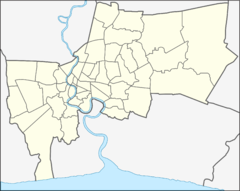| Kudi Charoenphat | |
|---|---|
กุฎีเจริญพาศน์ | |
 Imam Barah Charoenpasana, 2021 | |
| Religion | |
| Affiliation | Shia |
| District | Bangkok Yai |
| Province | Bangkok |
| Region | Thonburi |
| Location | |
| Location | Itsaraphap Road, Wat Arun Subdistrict, Bangkok Yai District, Bangkok |
| Geographic coordinates | 13°44′13″N 100°29′12″E / 13.736853°N 100.486734°E |
| Architecture | |
| Style | Gingerbread |
| Founder | Phraya Chula Ratchamontri II (Akayi) |
| Completed | 1785 |
Kudi Charoenphat (Thai: กุฎีเจริญพาศน์) is a Mosque of Muslim Shia sect or Chao Sen (เจ้าเซ็น) in Thai perception, it was built during the reign of King Phutthayotfa Chulalok (Rama I) by Phraya Chula Ratchamontri II (Akayi) since early Rattanakosin era.
The second mosque after Kudi Luang (กุฎีหลวง) is located by Bang Luang Canal, also known as Bangkok Yai Canal side close to Charoenphat Bridge (สะพานเจริญพาศน์). Formerly called Kudi Lang (กุฎีล่าง, "Lower Mosque") because it was located on the south of Kudi Bon (กุฎีบน, "Upper Mosque") which was situated on Chao Phraya River bank close to the Phra Racha Wang Derm (Thonburi Palace), the monastery's name has been changed to the present one since the reign of King Vajiravudh (Rama VI) when Charoenphat Bridge was constructed. The Building was built in Manila-styled and gingerbread, decorated with beautiful fretworks.
Nowadays, Charoenphat area is the most populated quarter of Chao Sen Muslims. The area is annually used by Chao Sen Shia sect Muslims in the religious ceremony in Muharram (the first month of Muslim calendar).[1]
For the word "Kudi" or "Kadi" (กะดี), as defined by the Royal Institute Dictionary means "The cottage of priest, monk and meaning place of worship of Islam Shia sect".[2]
- ^ "กุฎีเจริญพาศน์: สายสัมพันธ์ศาสนาและชุมชน" [Kudi Charoenphat: Religious and Community Relations]. Sarakadee Magazine (in Thai). 2015-08-17. Retrieved 2019-01-15.
- ^ "สถานที่สำคัญทางศาสนา กุฎีเจริญพาศน์" [Place of worship Kudi Charoenphat]. Golden Jubilee Network (in Thai). Archived from the original on 2018-12-23. Retrieved 2019-01-15.
